The Evolution of Agile Leadership in Modern Business
We need leaders who can take decisions and go through uncertainty in the developing phase of a business.
With quick changes by using adaptability and building strong teams agile leaders can guide organizations to a better goal.
Key Article Highlights
- Essential traits of successful agile leaders
- Proven frameworks for agile decision-making
- Practical steps to develop agility skills
- Real implementation strategies across industries
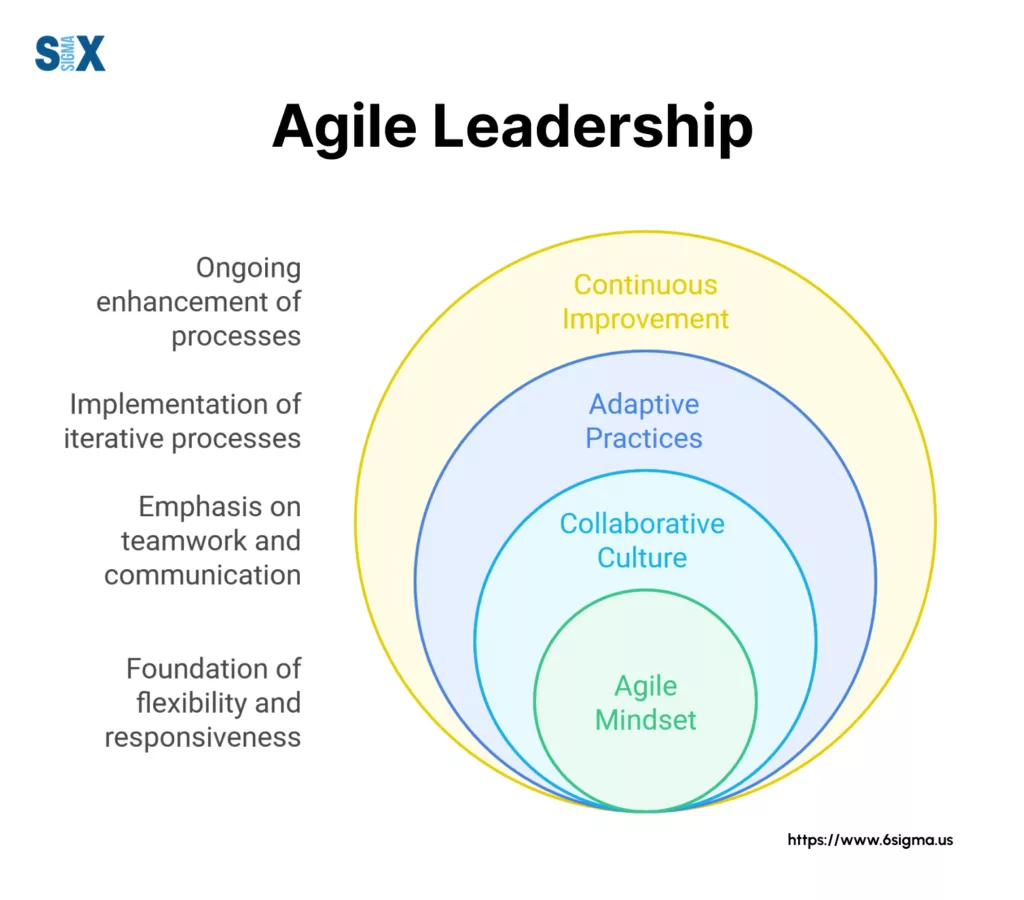
What is Agile Leadership?
The one who drives organizational success by quickly adapting to changing trends while maintaining the main focus.
These leaders excel in uncertain environments by combining flexibility with clear direction, enabling teams to innovate and deliver value consistently.
The Foundation: Three Core Principles
The first principle centers on adaptability. Agile leaders adjust their strategies based on real-time feedback and changing market conditions.
They encourage experimentation and view setbacks as learning opportunities.
The second principle focuses on empowerment. Rather than controlling every decision, agile leaders trust their teams to solve problems independently.
They provide guidance and support while removing obstacles that hinder progress.
The third principle emphasizes continuous improvement. These leaders actively seek feedback, measure results, and refine their approaches.
They model learning behavior and create environments where innovation thrives.
Master the Core Principles of Agile Leadership
Enroll in our Six Sigma Champion Leadership program to develop essential leadership skills.

The 3 C’s of Agile Leadership
Communication forms the bedrock of agile leadership. Leaders must share clear vision and expectations while remaining open to dialogue.
They facilitate transparent discussions across teams and organizational levels.
Commitment drives sustainable change. Agile leaders demonstrate unwavering dedication to organizational goals while remaining flexible about implementation methods.
They inspire similar commitment from their teams through consistent actions and support.
Collaboration enables innovation and problem-solving. These leaders break down silos and foster cross-functional partnerships.
They create spaces where diverse perspectives contribute to better solutions.
Traditional Versus Agile Leadership
Traditional leaders often rely on hierarchical structures and fixed processes. They prioritize control and predictability, making decisions from the top down.
While this approach worked in stable markets, it struggles in today’s dynamic environment.
Agile leaders, by contrast, build networks of empowered teams. They distribute decision-making authority and encourage experimentation.
This approach speeds up response times and improves organizational adaptability.
Consider these key differences:
Traditional leaders plan extensively before acting. Agile leaders start with direction and adjust based on results.
Traditional leaders control information flow. Agile leaders promote open communication and transparency.
Traditional leaders avoid risks. Agile leaders manage risks through small experiments and quick learning cycles.

The success of agile leadership depends on balancing these elements while maintaining focus on organizational goals.
Modern leaders must develop these capabilities to guide their organizations through rapid change and uncertainty.
This approach to leadership delivers measurable benefits: faster decision-making, improved employee engagement, and better business outcomes.
Organizations led by agile principles consistently outperform their peers in rapidly changing markets.
Characteristics of Successful Agile Leaders
Successful agile leaders demonstrate distinct traits that set them apart in today’s fast-paced business environment.
These characteristics enable them to guide teams effectively through uncertainty while maintaining focus on strategic objectives.
Adaptability in Decision-Making
The most effective agile leaders pivot strategies quickly based on new information. They remain flexible in their approaches, adjusting plans when market conditions change.
This adaptability extends to their management style, as they modify their leadership approach based on team needs and project requirements.
Rather than sticking to rigid plans, these leaders encourage experimentation and quick iterations. They view change as an opportunity for growth rather than a disruption to be avoided.
Continuous Learning Mindset with Agile Leadership
Agile leaders prioritize learning at all levels of the organization. They actively seek feedback from team members, stakeholders, and customers.
This commitment to improvement drives innovation and helps organizations stay ahead of market trends.
They also create environments where teams feel safe to experiment and learn from failures. By modeling continuous learning behaviors, these leaders foster cultures where growth and development thrive.
Team Empowerment and Trust
Successful agile leaders build strong, self-organizing teams. They delegate authority and trust team members to make decisions within their areas of expertise.
This empowerment leads to faster decision-making and increased innovation.
These leaders remove obstacles that hinder team progress and provide resources needed for success. They focus on outcomes rather than controlling every aspect of how work gets done.
Creating Collaborative Cultures
Innovation flourishes in environments where diverse perspectives come together. Agile leaders break down organizational silos and encourage cross-functional collaboration.
They create spaces where teams can share ideas freely and work together effectively.
These leaders also foster psychological safety, ensuring team members feel comfortable expressing opinions and taking calculated risks.
Strategic Vision and Execution Balance with Agile Leadership
While maintaining flexibility, agile leaders never lose sight of strategic objectives.
They balance short-term adaptability with long-term vision, ensuring teams understand how their work connects to broader organizational goals.
This balance helps organizations remain stable during change while continuing to evolve and improve.
Leaders achieve this by setting clear priorities and helping teams focus on high-value activities.
Emotional Intelligence in Leadership
Self-awareness forms the foundation of effective agile leadership. These leaders understand their own strengths and limitations while remaining attuned to team members’ needs and emotions.
They demonstrate empathy in their interactions and build strong relationships across the organization.
This emotional intelligence helps them navigate complex situations and maintain team motivation during challenging times.
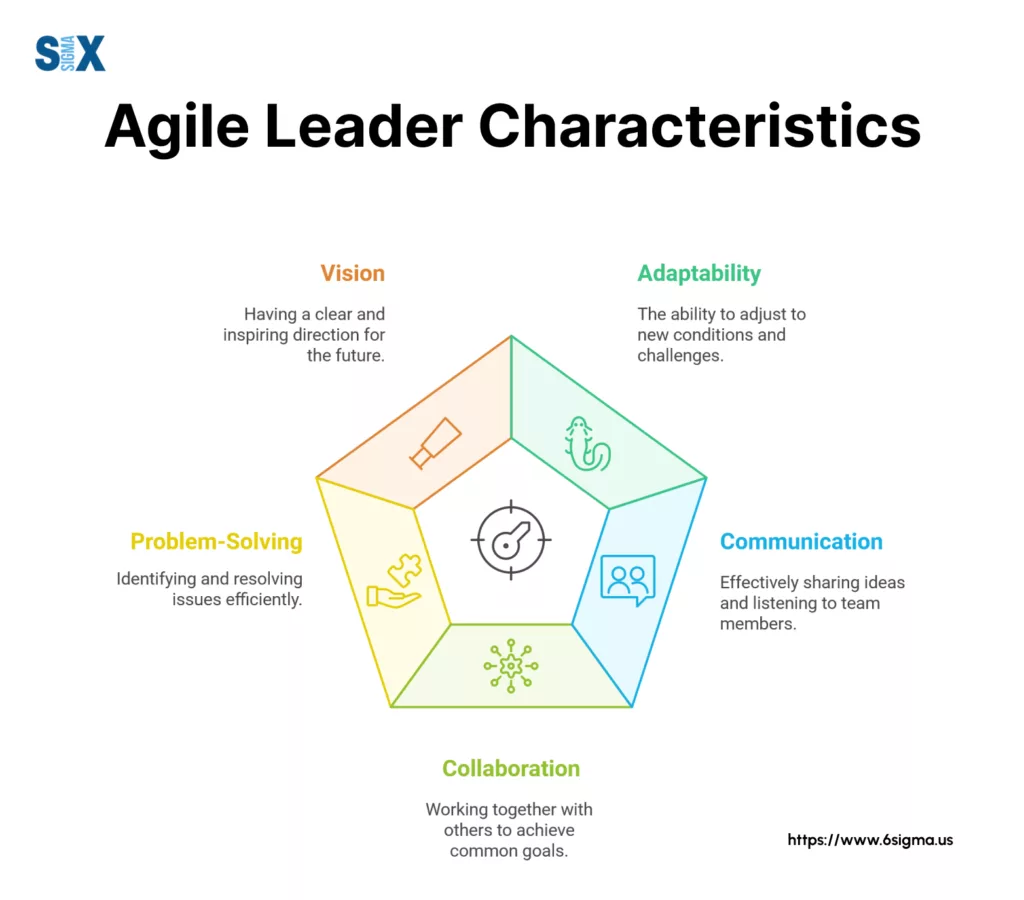
The leadership style of agile leaders evolves continuously as they develop these characteristics.
Success requires dedication to personal growth and a genuine commitment to organizational improvement through agile principles.
Organizations led by leaders who embody these characteristics consistently outperform their competitors in areas of innovation, employee satisfaction, and market adaptability.
These traits form the foundation of effective agile leadership in modern business environments.
Transform your leadership approach with our Lean Introduction certification.
Learn how to build and guide high-performing agile teams.
Developing Agile Leadership Skills
Becoming an agile leader requires deliberate practice and consistent effort. Organizations need leaders who can adapt quickly while maintaining team effectiveness and strategic focus.
This development journey starts with honest self-assessment and continues through practical application.
Starting With Self-Assessment
The first step in developing agile leadership capabilities involves evaluating current strengths and growth areas.
Leaders should examine their decision-making patterns, communication styles, and ability to adapt to change.
Regular feedback from team members and peers provides valuable insights into leadership effectiveness.
Key assessment areas include:
- Decision-making flexibility
- Team empowerment practices
- Communication effectiveness
- Change management abilities
- Strategic thinking skills
Practical Development Strategies with Agile Leadership
Successful agile leaders build their skills through structured practice and real-world application. They start with small changes in their leadership approach and gradually expand their capabilities.
Reading industry publications and attending workshops helps build theoretical knowledge. However, true skill development comes from applying these concepts in daily work situations.
Leaders should seek opportunities to practice agile principles in low-risk situations before tackling more challenging scenarios.
Navigating Common Transition Challenges
The shift to agile leadership often encounters resistance and setbacks.
Many leaders struggle with delegating authority or maintaining strategic focus while remaining flexible. Understanding these challenges helps create effective solutions.
- Common obstacles include:
- Traditional organizational structures
- Resistance to change from team members
- Balancing control with empowerment
- Maintaining consistency during transformation
Solutions involve gradual implementation, clear communication about changes, and demonstrating early wins. Supporting teams through the transition helps build trust and acceptance of new leadership approaches.
Tools and Frameworks for Skill Development
Several proven frameworks support agile leadership development. The Agile Leadership Competency Model provides a structured approach to skill building.
Leadership assessment tools help track progress and identify areas for improvement.
Digital platforms offer practical exercises and simulations for practicing agile leadership skills.
These tools provide safe environments for experimenting with new approaches before implementing them in real situations.
Measuring Progress and Success with Agile Leadership
Regular evaluation helps track development progress. Leaders should establish clear metrics for measuring their growth in key agile leadership areas. These might include:
- Team performance indicators
- Adaptation speed to change
- Employee engagement levels
- Innovation metrics
- Project success rates
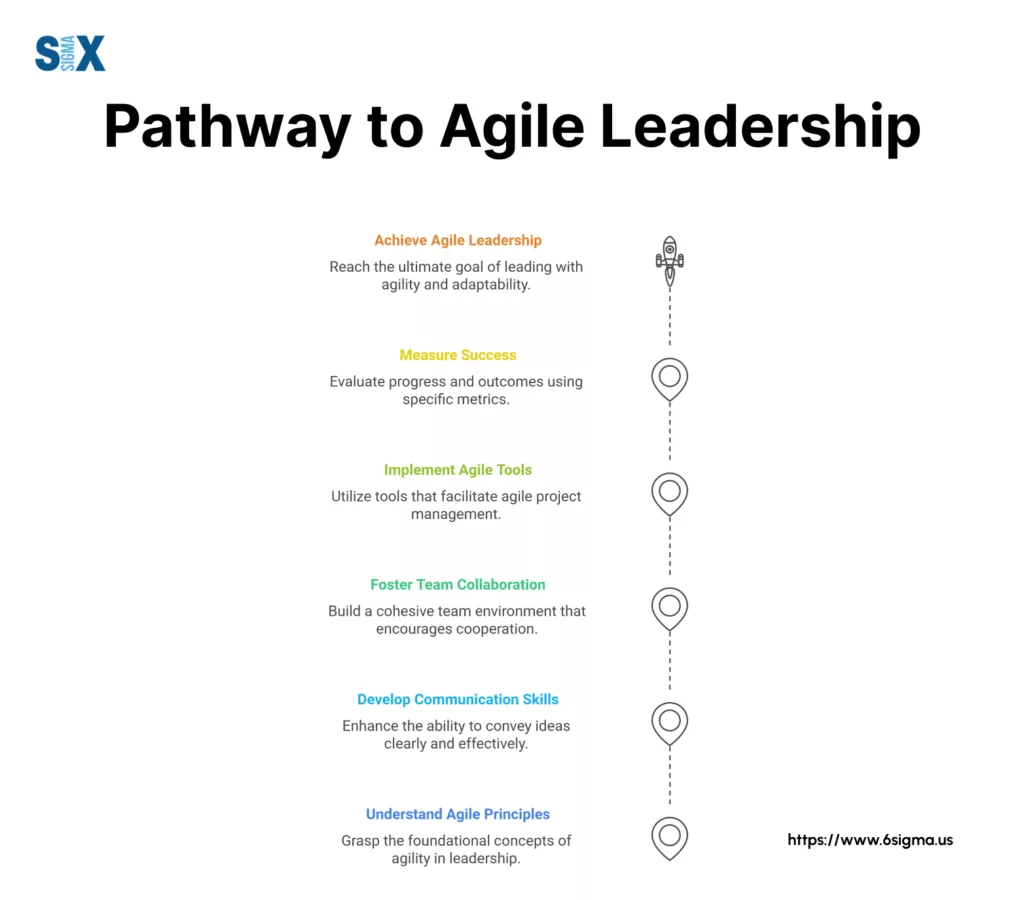
Building Long-Term Success
Becoming an agile leader professional requires ongoing commitment to growth and development.
Leaders must continuously refine their skills while helping others develop their agile capabilities.
Success in agile leadership comes from consistent application of principles, willingness to learn from mistakes, and dedication to team development.
Organizations that invest in developing agile leaders often see improved performance across all business metrics.
The journey to agile leadership never truly ends.
Agile Leadership in Modern Work Environments
The rise of remote and hybrid work models has transformed how agile team leaders guide their organizations.
Modern work environments demand new approaches to collaboration, communication, and team engagement while maintaining agile principles.
Leading Remote and Hybrid Teams
Remote work environments require agile leaders to adapt their communication strategies.
Digital tools and virtual meetings replace traditional face-to-face interactions, making clear communication even more crucial.
Leaders must create structured yet flexible frameworks that enable team collaboration across different time zones and locations.
Successful team leaders in agile environments establish regular check-ins without micromanaging.
They leverage technology to maintain team cohesion while respecting work-life boundaries.
Virtual team building activities and informal communication channels help maintain strong team relationships despite physical distance.
Managing Global and Diverse Teams with Agile Leadership
Cultural awareness becomes paramount when leading global teams. Agile leaders must navigate different communication styles, work practices, and cultural expectations.
They create inclusive environments where diverse perspectives enhance team performance rather than create barriers.
Time zone differences require thoughtful planning of meetings and collaborative sessions.
Leaders establish clear protocols for asynchronous work while ensuring all team members have equal opportunities to contribute and engage.
Strategic Planning in Virtual Environments
Long-term planning takes on new dimensions in remote settings. Agile leaders balance flexibility with strategic focus by:
- Creating clear roadmaps visible to all team members
- Establishing digital channels for strategy discussions
- Implementing regular strategy review sessions
- Adjusting plans based on remote team feedback
- Maintaining alignment across distributed teams
Measuring Remote Team Success with Agile Leadership
Digital environments offer new opportunities for measuring team performance and leadership effectiveness. Key metrics include:
- Team velocity and productivity trends
- Virtual collaboration effectiveness
- Employee engagement levels
- Project completion rates
- Innovation outcomes
Leaders use these metrics to adjust their approaches and support team success in remote settings.
Building Virtual Team Culture
Strong team cultures remain essential in remote environments.
Agile leaders foster connection and belonging through:
- Regular virtual team celebrations
- Recognition of achievements
- Open forums for feedback and discussion
- Shared learning opportunities
- Cross-functional collaboration initiatives
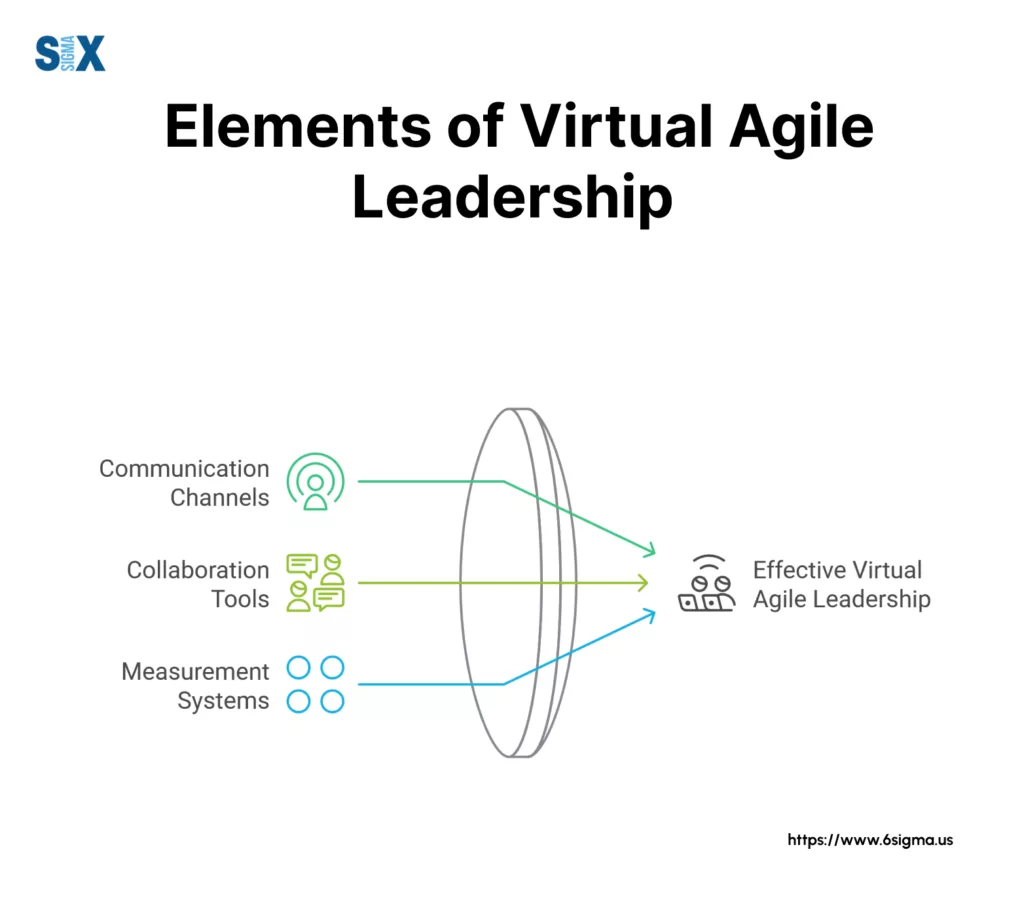
Technology Integration and Tools
Modern agile leaders must master digital collaboration tools.
They select and implement technologies that support team effectiveness while avoiding tool overload. The focus remains on using technology to enable better team outcomes rather than adding complexity.
Future-Proofing Leadership Approaches
As work environments continue evolving, agile leaders must stay ahead of trends.
They experiment with new leadership approaches while maintaining core agile principles. This includes:
- Adopting emerging collaboration technologies
- Developing new virtual team engagement strategies
- Creating flexible work policies
- Building sustainable remote work practices
The success of agile leadership in modern work environments depends on balancing traditional leadership principles with new approaches suited to virtual and hybrid settings.
Leaders who master this balance position their teams for sustained success in evolving business landscapes.
Measuring the impact of these leadership approaches provides valuable insights for continuous improvement.
Regular assessment and adjustment of virtual leadership strategies ensure teams remain effective and engaged in remote settings.
Certifications and Career Development for Agile Leaders
Professional certifications validate leadership capabilities and open new career opportunities in agile environments.
Organizations increasingly seek certified agile leaders who demonstrate both theoretical knowledge and practical expertise.
Essential Agile Leadership Certifications
The Certified Agile Leader program offers foundational knowledge for executives and managers.
This certification focuses on organizational transformation, leadership principles, and agile mindset development.
Participants learn practical approaches to leading agile teams and driving organizational change.
Advanced certifications like the Professional Agile Leadership certification delve deeper into specific aspects of agile leadership.
These programs emphasize practical application and real-world problem-solving skills.
Career Growth Opportunities
Certified agile leaders find opportunities across various industries and roles. Common career paths include:
- Agile Transformation Lead
- Enterprise Agile Coach
- Chief Transformation Officer
- Director of Agile Practices
- Senior Program Manager
Organizations value leaders who combine technical expertise with strong leadership capabilities. The demand for qualified agile leaders continues growing as more companies embrace agile methodologies.
Salary and Compensation Trends
The certified agile leader salary reflects the high demand for qualified professionals. Entry-level positions typically start at $95,000 annually, while experienced leaders often earn $150,000 or more. Factors affecting compensation include:
- Industry sector
- Geographic location
- Years of experience
- Certification level
- Organization size
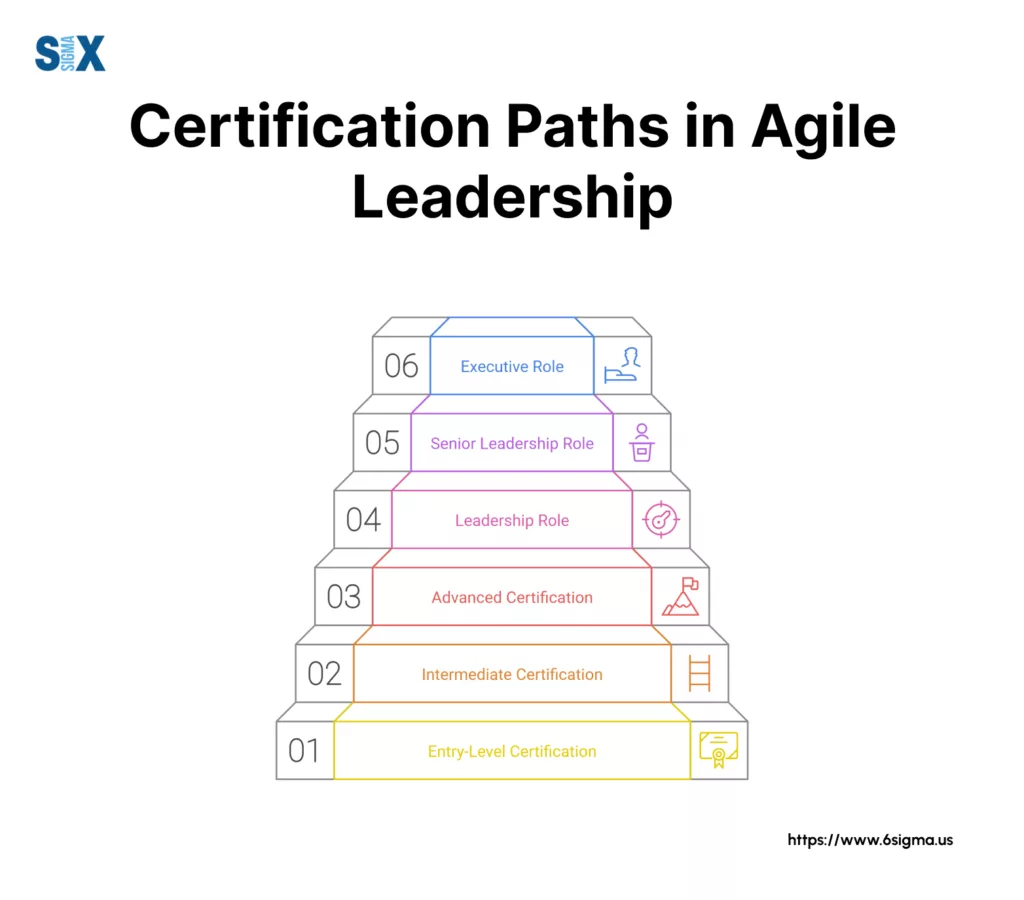
Conclusion
Agile leadership transforms organizations by fostering innovation, adaptability, and sustainable growth.
The journey to becoming an effective agile leader requires dedication, continuous learning, and practical application of agile principles.
Key Takeaways
Successful agile leaders balance flexibility with strategic focus. They build strong teams through clear communication, trust, and empowerment.
Modern work environments demand new approaches to leadership, while maintaining core agile values.
Professional development through certifications provides structured paths for growth. Organizations benefit from leaders who combine formal training with practical experience in agile methodologies.
Looking Forward
The future of agile leadership continues evolving with technological advances and changing work environments.
Leaders must stay current with emerging trends while maintaining focus on fundamental leadership principles.
Success in agile leadership comes from:
- Embracing continuous learning
- Adapting to change
- Building strong teams
- Maintaining strategic focus
- Developing emotional intelligence
Organizations that invest in developing agile leaders position themselves for success in rapidly changing markets.
The commitment to agile leadership principles drives innovation, improves team performance, and creates sustainable competitive advantages.
The path to agile leadership excellence remains open to those willing to learn, adapt, and grow.
Through dedicated practice and continuous improvement, leaders can build the skills needed to guide their organizations toward future success.
SixSigma.us offers both Live Virtual classes as well as Online Self-Paced training. Most option includes access to the same great Master Black Belt instructors that teach our World Class in-person sessions. Sign-up today!
Virtual Classroom Training Programs Self-Paced Online Training Programs






